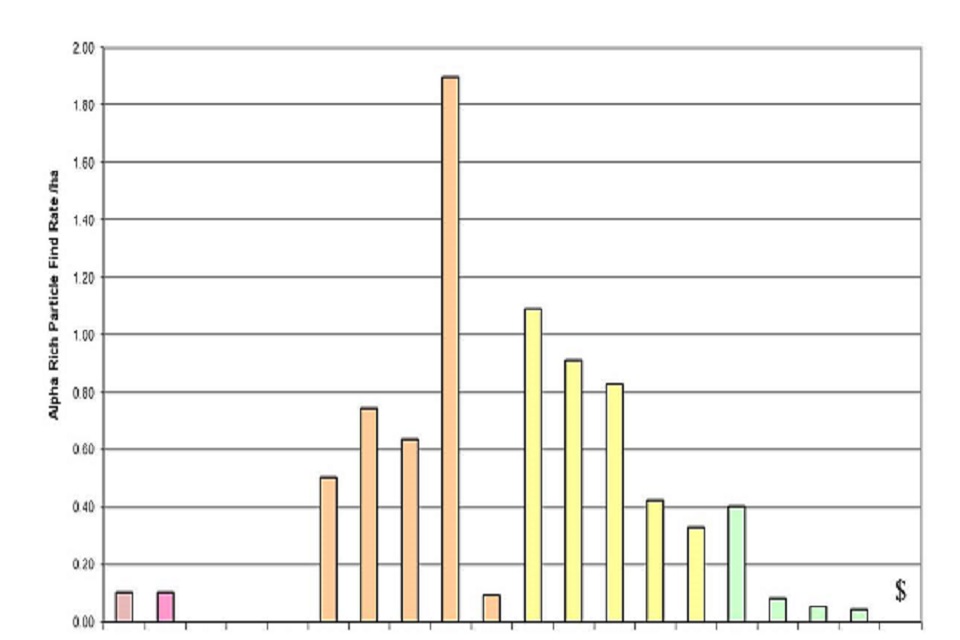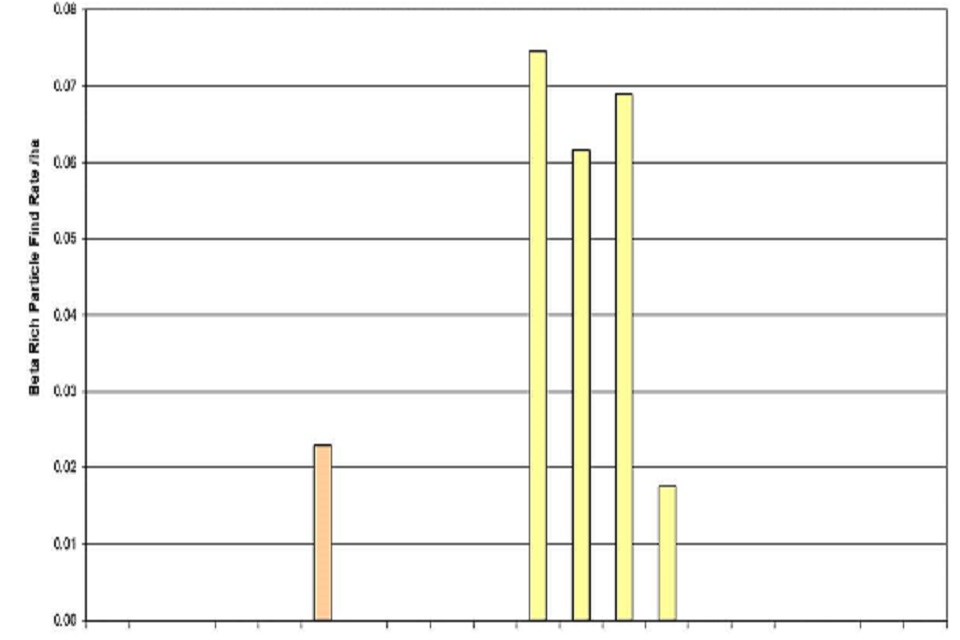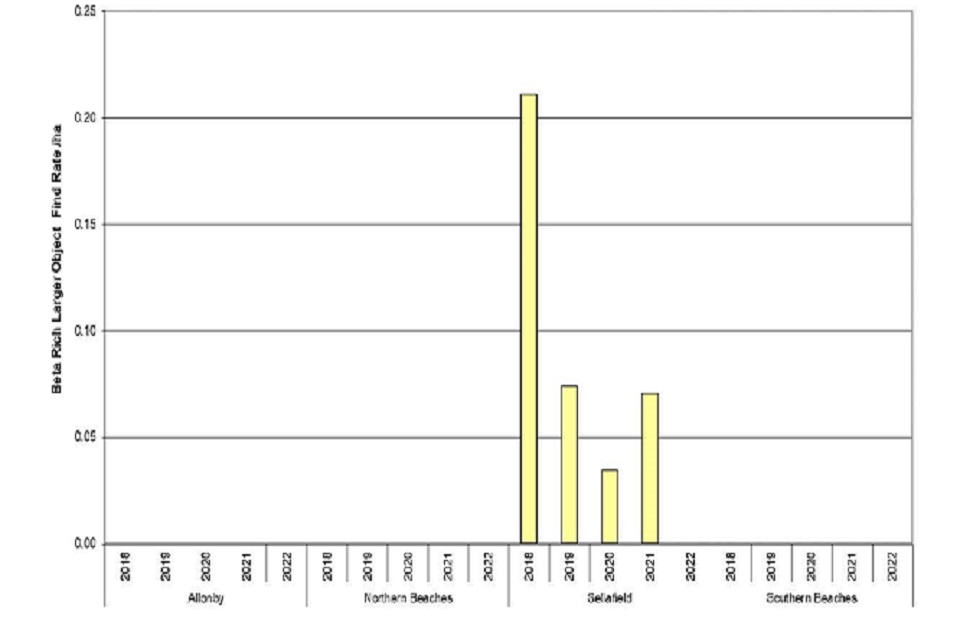Particles in the Environment Update - Q1 2022
Published 6 June 2022
1. Progress and areas monitored
During the period 01 January to 31 March 2022 (Q1 2022) a total area of 27 ha of the beaches along the Cumbrian coast were monitored against a programme target of 22 ha.
A total of 7 particles and no larger objects (1) were detected, recovered and analysed, see Table 1. The overall target for the 2022 programme is to monitor an area of 105 ha. Further details of the programme can be found in the annual report series (2).
A strandline survey was conducted between the 22 to 24 March from Drigg Point to St. Bees Head, excluding the foreshore at Nethertown where vehicle access is not possible. No finds were detected or recovered.
2. Find rates
Average find rates were compared with find rates over the last 2 calendar years in table 2 and the last 4 years in figure 1. For clarity of presentation, the find rates in table 2 were rounded to the nearest significant figure.
Table 2 and figure 1 shows that Alpha-rich particle³, Beta-rich particle and Beta-rich larger object find rates at Sellafield beach were comparable with the average find rates from the previous years.
Alpha-rich particle find rates at northern beaches were lower than those measured at this area in recent years.
Find rates in Q1 2022 did not require any form of intervention through the Environment Agency intervention protocol (4).
3. Find activities
Figure 2 shows the activities of Alpha-rich particles were comparable to the activities measured since May 2014 (when the current version of the monitoring equipment was introduced).
None of the finds recovered in Q1 2022 required characterisation through the Environment Agency Characterisation Protocol (4).
4. Summary of programme
Table 3 presents a summary of the beach monitoring programme since it started in 2006. Overall, a total of 2618 ha of beaches have been monitored and 3,439 particles and larger objects have been recovered and analysed.
5. Conclusion
The Public Health England risk assessment for radioactive particles and larger objects on West Cumbrian beaches reported that
- overall health risks for beach users are very low, and significantly lower than other risks that people accept when using the beaches
- measures to control these risks are not warranted on public health grounds
5.1 Note:
- Particles are finds < 2 mm in diameter and “larger objects” are finds >= 2mm in diameter (includes: granules, gravel, pebbles, stones etc.)
- [https://www.gov.uk/government/collections/sellafield-ltd-environmental-and-safety-reports[(https://www.gov.uk/government/collections/sellafield-ltd-environmental-and-safety-report)
- Alpha-rich are finds with 241Am activity greater than 137Cs activity, “Beta-rich” are finds with 137Cs activity greater than 241Am activity and “Co-60 rich” are finds with positive 60Co activity greater than the 137Cs activity.
- https://www.gov.uk/government/collections/sellafield-ltd-environmental-and-safety-report
6. Table 1: Beach finds in 2022
| Beach location | Areas covered (ha) | No. of particles found Alpha-rich | No. of particles found Beta-rich | No. of particles found other | No. of particles found not analysed | No. of larger objects found Alpha-rich | No. of larger objects found Beta-rich | No. of larger particles found other | No. of larger objects found not analysed | Total finds |
|---|---|---|---|---|---|---|---|---|---|---|
| Allonby | 0 | 0 | 0 | 0 | 0 | 0 | 0 | 0 | 0 | 0 |
| Northern beaches | 11 | 1 | 0 | 0 | 0 | 0 | 0 | 0 | 0 | 4 |
| Sellafield | 12 | 4 | 0 | 0 | 0 | 0 | 0 | 0 | 0 | 0 |
| Southern beaches | 4 | 2 | 0 | 0 | 0 | 0 | 0 | 0 | 0 | 4 |
| All | 27 | 7 | 0 | 0 | 0 | 0 | 0 | 0 | 0 | 7 |
Note 1 - Proportion of particles as % of total finds 100%
7. Table 2 : Find per hectare and area monitored for main beach areas
| Beach location | Year | Area covered (ha) | Find category and type (finds per hectare) alpha-rich particle | Find category and type (finds per hectare) beta-rich particle | Find category and type (finds per hectare) beta-rich larger object | Find category and type (finds per hectare) other finds |
|---|---|---|---|---|---|---|
| Allonby | 2020 | 6 | 0 | 0 | 0 | 0 |
| 2021 | 5 | 0 | 0 | 0 | 0 | |
| 2022 | 0 | N/A | N/A | N/A | N/A | |
| Northern beaches | 2020 | 30 | <1 | 0 | 0 | 0 |
| 2021 | 36 | 2 | 0 | 0 | 0 | |
| 2022 | 11 | <0.1 | 0 | 0 | 0 | |
| Sellafield | 2020 | 58 | <1 | <0.1 | <0.1 | 0 |
| 2021 | 57 | <1 | <0.1 | <0.1 | 0 | |
| 2022 | 12 | <1 | 0 | 0 | 0 | |
| Southern beaches | 2020 | 19 | <0.1 | 0 | 0 | 0 |
| 2021 | 24 | <0.1 | 0 | 0 | 0 | |
| 2022 | 4 | IA | 0 | 0 | 0 |
7.1 Note 2:
- IA - Insufficient area coverage to estimate finds rates (<10 ha)
- N/A - No monitoring to date
- “<1” denotes values between 0.1 and 0.99
- “<0.1” denotes values between zero and 0.099
8. Table 3: Summary of beach monitoring data since programme began in 2006
| Beach location | Area (ha) | Total particle | Total larger object | Alpha-rich particle | Alpha-rich larger object | Beta-rich particle | Beta-rich larger object | Co-60 rich particle | Co-60 rich larger object |
|---|---|---|---|---|---|---|---|---|---|
| Allonby | 118 | 18 | 1 | 16 | 0 | 2 | 1 | 0 | 0 |
| Northern beaches | 880 | 868 | 0 | 811 | 0 | 51 | 0 | 6 | 0 |
| Sellafield | 955 | 1672 | 720 | 1336 | 6 | 328 | 712 | 8 | 2 |
| Southern beaches | 586 | 134 | 6 | 109 | 0 | 25 | 4 | 0 | 2 |
| Other beaches | 78 | 19 | 1 | 17 | 0 | 2 | 1 | 0 | 0 |
| All | 2618 | 2711 | 728 | 2289 | 6 | 408 | 718 | 14 | 4 |
8.1 Note:
Northern beaches are St Bees and Braystones, southern beaches are Seascale and Drigg. Allonby and Sellafield are included specifically.
All other beaches (e.g. Whitehaven, Workington, Silecroft etc.) are incorporated into the “other beaches” definition.



Note: that some beta-rich particles have been reclassified as larger objects following analysis.
Figure 1: Find rates of alpha-rich particles (upper), beta-rich particles (middle) and beta-rich larger objects (lower) between 2018 to 2022. Note: that find rates in 2022 are for finds to date and not the annual rate.
Notes: $ Find rate not able to be calculated as it corresponds to a very limited amount of monitoring, see table 1.

Note 3: Different scales used for 2022 and Synergy2 datasets.
Figure 2: Radioactivity of finds classified as alpha-rich particles between May 2014 to December 2021 (termed “Synergy2” and shown in blue) compared to data from 2022 (termed “2022” and shown in red).

